by Calculated Risk on 3/10/2022 08:31:00 AM
Thursday, March 10, 2022
BLS: CPI increased 0.8% in February; Core CPI increased 0.5%
Note: This is pre-invasion, and there will be sharp increases in energy prices for March.
From the BLS:
The Consumer Price Index for All Urban Consumers (CPI-U) increased 0.8 percent in February on a seasonally adjusted basis after rising 0.6 percent in January, the U.S. Bureau of Labor Statistics reported today. Over the last 12 months, the all items index increased 7.9 percent before seasonal adjustment.Both CPI and core CPI were at expectations. I'll post a graph later today after the Cleveland Fed releases the median and trimmed-mean CPI.
Increases in the indexes for gasoline, shelter, and food were the largest contributors to the seasonally adjusted all items increase. The gasoline index rose 6.6 percent in February and accounted for almost a third of the all items monthly increase; other energy component indexes were mixed. The food index rose 1.0 percent as the food at home index rose 1.4 percent; both were the largest monthly increases since April 2020.
The index for all items less food and energy rose 0.5 percent in February following a 0.6-percent increase the prior month. The shelter index was by far the biggest factor in the increase, with a broad set of indexes also contributing, including those for recreation, household furnishings and operations, motor vehicle insurance, personal care, and airline fares.
The all items index rose 7.9 percent for the 12 months ending February. The 12-month increase has been steadily rising and is now the largest since the period ending January 1982. The all items less food and energy index rose 6.4 percent, the largest 12-month change since the period ending August 1982. The energy index rose 25.6 percent over the last year, and the food index increased 7.9 percent, the largest 12-month increase since the period ending July 1981.
emphasis added
Wednesday, March 09, 2022
Thursday: CPI, Unemployment Claims, Q4 Flow of Funds
by Calculated Risk on 3/09/2022 08:59:00 PM
Thursday:
• At 8:30 AM ET, The Consumer Price Index for February from the BLS. The consensus is for a 0.8% increase in CPI, and a 0.5% increase in core CPI. The consensus is for CPI to be up 7.9% Year-over-year (YoY), and core CPI to be up 6.4% YoY.
• Also at 8:30 AM, The initial weekly unemployment claims report will be released. The consensus is for a decrease to 210 thousand from 215 thousand last week.
• At 12:00 PM, Q4 Flow of Funds Accounts of the United States from the Federal Reserve.
On COVID (focus on hospitalizations and deaths):
| COVID Metrics | ||||
|---|---|---|---|---|
| Now | Week Ago | Goal | ||
| Percent fully Vaccinated | 65.2% | --- | ≥70.0%1 | |
| Fully Vaccinated (millions) | 216.4 | --- | ≥2321 | |
| New Cases per Day3 | 37,879 | 55,018 | ≤5,0002 | |
| Hospitalized3 | 28,090 | 40,581 | ≤3,0002 | |
| Deaths per Day3 | 1,161 | 1,683 | ≤502 | |
| 1 Minimum to achieve "herd immunity" (estimated between 70% and 85%). 2my goals to stop daily posts, 37-day average for Cases, Currently Hospitalized, and Deaths 🚩 Increasing 7-day average week-over-week for Cases, Hospitalized, and Deaths ✅ Goal met. | ||||
 Click on graph for larger image.
Click on graph for larger image.This graph shows the daily (columns) and 7-day average (line) of deaths reported.
Vehicle Sales Mix and Heavy Trucks
by Calculated Risk on 3/09/2022 02:22:00 PM
This graph shows the percent of light vehicle sales between passenger cars and trucks / SUVs through February 2022.
 Over time the mix has changed more and more towards light trucks and SUVs.
Over time the mix has changed more and more towards light trucks and SUVs.Only when oil prices are high, does the trend slow or reverse.
The percent of light trucks and SUVs was at 79.2% in February 2022 - just below the record high percentage of 80.0% last October.
The second graph shows heavy truck sales since 1967 using data from the BEA. The dashed line is the February 2022 seasonally adjusted annual sales rate (SAAR).
Heavy truck sales really collapsed during the great recession, falling to a low of 180 thousand SAAR in May 2009. Then heavy truck sales increased to a new all time high of 563 thousand SAAR in September 2019.
Note: "Heavy trucks - trucks more than 14,000 pounds gross vehicle weight."
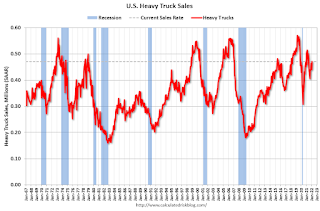 Heavy truck sales really declined at the beginning of the pandemic, falling to a low of 299 thousand SAAR in May 2020.
Heavy truck sales really declined at the beginning of the pandemic, falling to a low of 299 thousand SAAR in May 2020. BLS: Job Openings "little changed" at 11.3 million in January
by Calculated Risk on 3/09/2022 10:09:00 AM
From the BLS: Job Openings and Labor Turnover Summary
The number of job openings was little changed at 11.3 million on the last business day of January, the U.S. Bureau of Labor Statistics reported today. Hires and total separations were little changed at 6.5 million and 6.1 million, respectively. Within separations, the quits rate decreased to 2.8 percent. The layoffs and discharges rate was little changed at 0.9 percent.The following graph shows job openings (yellow line), hires (dark blue), Layoff, Discharges and other (red column), and Quits (light blue column) from the JOLTS.
emphasis added
This series started in December 2000.
Note: The difference between JOLTS hires and separations is similar to the CES (payroll survey) net jobs headline numbers. This report is for January, the employment report last Friday was for February.
 Click on graph for larger image.
Click on graph for larger image.Note that hires (dark blue) and total separations (red and light blue columns stacked) are usually pretty close each month. This is a measure of labor market turnover. When the blue line is above the two stacked columns, the economy is adding net jobs - when it is below the columns, the economy is losing jobs.
The huge spike in layoffs and discharges in March 2020 are labeled, but off the chart to better show the usual data.
Jobs openings decreased in January to 11.3 million from 11.4 million in December.
The number of job openings (yellow) were up 56% year-over-year.
Quits were up 28% year-over-year. These are voluntary separations. (See light blue columns at bottom of graph for trend for "quits").
MBA: Mortgage Applications Increase in Latest Weekly Survey
by Calculated Risk on 3/09/2022 07:00:00 AM
From the MBA: Mortgage Applications Increase in Latest MBA Weekly Survey
Mortgage applications increased 8.5 percent from one week earlier, according to data from the Mortgage Bankers Association’s (MBA) Weekly Mortgage Applications Survey for the week ending March 4, 2022.
... The Refinance Index increased 9 percent from the previous week and was 50 percent lower than the same week one year ago. The seasonally adjusted Purchase Index increased 9 percent from one week earlier. The unadjusted Purchase Index increased 11 percent compared with the previous week and was 7 percent lower than the same week one year ago.
"Mortgage rates dropped for the first time in 12 weeks, as the war in Ukraine spurred an investor flight to quality, which pushed U.S. Treasury yields lower. A 6-basis-point decline in the 30-year fixed-rate mortgage led to a slight rebound in total refinance activity, with a larger gain in government refinances. Looking ahead, the potential for higher inflation amidst disruptions in oil and other commodity flows will likely lead to a period of volatility in rates as these effects work against each other,” said Joel Kan, MBA’s Associate Vice President of Economic and Industry Forecasting. “Purchase activity also increased, as prospective buyers acted on lower rates and the early start of the spring buying season. The average loan size remained close to record highs, with higher-balance loan applications continuing to dominate growth.
...
The average contract interest rate for 30-year fixed-rate mortgages with conforming loan balances ($647,200 or less) decreased to 4.09 percent from 4.15 percent, with points remaining unchanged at 0.44 (including the origination fee) for 80 percent loan-to-value ratio (LTV) loans.
emphasis added
 Click on graph for larger image.
Click on graph for larger image.The first graph shows the refinance index since 1990.
The second graph shows the MBA mortgage purchase index
 According to the MBA, purchase activity is down 7% year-over-year unadjusted.
According to the MBA, purchase activity is down 7% year-over-year unadjusted.Note: Red is a four-week average (blue is weekly).
Tuesday, March 08, 2022
Wednesday: Job Openings
by Calculated Risk on 3/08/2022 08:55:00 PM
Wednesday:
• At 7:00 AM ET, The Mortgage Bankers Association (MBA) will release the results for the mortgage purchase applications index.
• At 10:00 AM, Job Openings and Labor Turnover Survey for January from the BLS.
On COVID (focus on hospitalizations and deaths):
| COVID Metrics | ||||
|---|---|---|---|---|
| Now | Week Ago | Goal | ||
| Percent fully Vaccinated | 65.1% | --- | ≥70.0%1 | |
| Fully Vaccinated (millions) | 216.3 | --- | ≥2321 | |
| New Cases per Day3 | 40,433 | 66,869 | ≤5,0002 | |
| Hospitalized3 | 29,633 | 42,589 | ≤3,0002 | |
| Deaths per Day3 | 1,208 | 1,887 | ≤502 | |
| 1 Minimum to achieve "herd immunity" (estimated between 70% and 85%). 2my goals to stop daily posts, 37-day average for Cases, Currently Hospitalized, and Deaths 🚩 Increasing 7-day average week-over-week for Cases, Hospitalized, and Deaths ✅ Goal met. | ||||
 Click on graph for larger image.
Click on graph for larger image.This graph shows the daily (columns) and 7-day average (line) of deaths reported.
Leading Index for Commercial Real Estate "Recovers in February"
by Calculated Risk on 3/08/2022 02:00:00 PM
From Dodge Data Analytics: Dodge Momentum Index Recovers in February
The Dodge Momentum Index increased 4% in February to 158.2 (2000=100), from the revised January reading of 151.9. The Momentum Index, issued by Dodge Construction Network, is a monthly measure of the initial report for nonresidential building projects in planning, which have been shown to lead construction spending for nonresidential buildings by a full year. In February, institutional planning rose 9%, and commercial planning moved 1% higher.
The Dodge Momentum Index rebounded from three consecutive monthly declines that followed a 14-year high in October 2021. Much of February’s gain was due to a sizeable jump in the institutional component, as more education and healthcare projects entered planning. Commerical planning remained solid thanks to office and warehouse projects. When compared to February 2021, the overall Momentum Index was 11% higher in February 2022. The institutional component was up 37%, while the commercial component was down 1% on a year-over-year basis.
emphasis added
 Click on graph for larger image.
Click on graph for larger image.This graph shows the Dodge Momentum Index since 2002. The index was at 158.2 in February, up from 151.9 in January.
According to Dodge, this index leads "construction spending for nonresidential buildings by a full year". This index suggested a decline in Commercial Real Estate construction through most of 2021, but a solid pickup in 2022.
1st Look at Local Housing Markets in February
by Calculated Risk on 3/08/2022 10:27:00 AM
Today, in the Calculated Risk Real Estate Newsletter: 1st Look at Local Housing Markets in February
A brief excerpt:
Here is a summary of active listings for these housing markets in February. Inventory was up 2.4% in February month-over-month (MoM) from January, and down 30.0% year-over-year (YoY).There is much more in the article. You can subscribe at https://calculatedrisk.substack.com/
It appears inventory has bottomed seasonally in some areas. Last month, these markets were down 38.8% YoY, so the YoY decline in February is smaller than in January. This isn’t indicating a slowing market, but maybe a few baby steps towards a more balanced market in some areas.
Notes for all tables:
1) New additions to table in BOLD.
2) Northwest (Seattle) and Santa Clara (San Jose)
Trade Deficit Increased to $89.7 Billion in January
by Calculated Risk on 3/08/2022 08:42:00 AM
From the Department of Commerce reported:
The U.S. Census Bureau and the U.S. Bureau of Economic Analysis announced today that the goods and services deficit was $89.7 billion in January, up $7.7 billion from $82.0 billion in December, revised.
January exports were $224.4 billion, $3.9 billion less than December exports. January imports were $314.1 billion, $3.8 billion more than December imports.
emphasis added
 Click on graph for larger image.
Click on graph for larger image.Exports decreased and imports increased in January.
Exports are up 15% compared to January 2021; imports are up 21% year-over-year.
Both imports and exports decreased sharply due to COVID-19, and have now bounced back (imports more than exports),
The second graph shows the U.S. trade deficit, with and without petroleum.
 The blue line is the total deficit, and the black line is the petroleum deficit, and the red line is the trade deficit ex-petroleum products.
The blue line is the total deficit, and the black line is the petroleum deficit, and the red line is the trade deficit ex-petroleum products.Note that net, imports and exports of petroleum products are close to zero.
The trade deficit with China increased to $36.4 billion in January, from $26.3 billion in January 2021.
Monday, March 07, 2022
Tuesday: Trade Deficit
by Calculated Risk on 3/07/2022 09:14:00 PM
From Matthew Graham at Mortgage News Daily: Mortgage Rates Jump Back Up to Start The Week
Mortgage rates have experienced significant volatility so far in 2022. At first, this was almost exclusively a function of the Federal Reserve or, rather, the market's reaction to changes being discussed by the Fed. It was also almost exclusively biased toward higher rates.Tuesday:
Since late February, Ukraine is the key consideration for financial markets. At first, this pushed rates noticeably lower, but that trend has leveled off as of last week. Now we're seeing rates move broadly sideways in the bigger picture, with extreme volatility at times. [30 year fixed 4.09%]
emphasis added
• At 6:00 AM ET, NFIB Small Business Optimism Index for February.
• At 8:30 AM, Trade Balance report for January from the Census Bureau. The consensus is the trade deficit to be $87.1 billion. The U.S. trade deficit was at $80.7 Billion in December.
On COVID (focus on hospitalizations and deaths):
| COVID Metrics | ||||
|---|---|---|---|---|
| Now | Week Ago | Goal | ||
| Percent fully Vaccinated | 65.1% | --- | ≥70.0%1 | |
| Fully Vaccinated (millions) | 216.2 | --- | ≥2321 | |
| New Cases per Day3 | 42,204 | 62,266 | ≤5,0002 | |
| Hospitalized3 | 29,837 | 44,714 | ≤3,0002 | |
| Deaths per Day3 | 1,259 | 1,723 | ≤502 | |
| 1 Minimum to achieve "herd immunity" (estimated between 70% and 85%). 2my goals to stop daily posts, 37-day average for Cases, Currently Hospitalized, and Deaths 🚩 Increasing 7-day average week-over-week for Cases, Hospitalized, and Deaths ✅ Goal met. | ||||
 Click on graph for larger image.
Click on graph for larger image.This graph shows the daily (columns) and 7-day average (line) of deaths reported.
Homebuilder Comments in February: “Demand is still high"
by Calculated Risk on 3/07/2022 05:28:00 PM
Today, in the Calculated Risk Real Estate Newsletter: Homebuilder Comments in February: “Demand is still high"
A brief excerpt:
Some homebuilder comments courtesy of Rick Palacios Jr., Director of Research at John Burns Real Estate Consulting (a must follow for housing on twitter!):There is much more in the article. You can subscribe at https://calculatedrisk.substack.com/
Here is Rick’s summary of builder comments for various markets (emphasis added in bold):
Homebuilder survey results are in for February. Top themes: 1) Record high new home price increases at +20% YOY nationally. 2) Record low builder finished inventory. 3) Demand still off the charts & quality of home buyer prospect lists still solid. Market commentary to follow ...
#Charlotte builder: “We’ve stopped selling homes in the majority of our communities due to supply chain & labor delays. We release homes for sale once they get to drywall stage. This will throw off our community counts & sales numbers."
#Boston builder: “We continue to limit lot releases, even sold our models. Our agents are not holding open houses nor advertising. Lots are reserved within days of release.”
#Nashville builder: “Market is still extremely strong even with rates moving up. Still a large shortage of homes on the market.”
#Dallas builder: “We’re limiting sales to spec inventory in order to limit inflation risk.”
#Austin builder: “Traditional detached sales (entry level and move-up) continued to be very strong in February."
Black Knight Mortgage Monitor for January: "$275 billion in equity withdrawn" in 2021
by Calculated Risk on 3/07/2022 12:45:00 PM
Today, in the Calculated Risk Real Estate Newsletter: Black Knight Mortgage Monitor for January: "$275 billion in equity withdrawn" in 2021
A brief excerpt:
And on the payment to income ratio (this is high):There is much more in the article. You can subscribe at https://calculatedrisk.substack.com/
• Rising home prices and interest rates continue to put significant pressure on home buyers
• The principal and interest payment required to buy the average-priced home is up $186 (14%) over the first two months of the year and $417 (37%) year-over-year
• It now requires 27.5% of the median household income to purchase the average home – well above the long-term affordability benchmark of 25%, though still below the high of 34% during the pre-Great Recession bubble
• From 2013 through 2019, a payment-to-income ratio of 21.5% universally corresponded with home price deceleration – a trend that's been shattered in the post-pandemic world
Housing Inventory March 7th Update: Inventory Down 1.4% Week-over-week; New Record Low; Possible Bottom
by Calculated Risk on 3/07/2022 09:42:00 AM
Tracking existing home inventory is very important in 2022.
Inventory usually declines in the winter, and this is a new record low for this series.
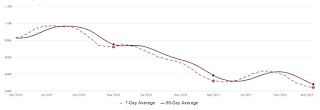
This inventory graph is courtesy of Altos Research.
| Week Ending | YoY Change |
|---|---|
| 12/31/2021 | -30.0% |
| 1/7/2022 | -26.0% |
| 1/14/2022 | -28.6% |
| 1/21/2022 | -27.1% |
| 1/28/2022 | -25.9% |
| 2/4/2022 | -27.9% |
| 2/11/2022 | -27.5% |
| 2/18/2022 | -25.8% |
| 2/25/2022 | -24.9% |
| 3/4/2022 | -24.2% |
Based on the trend, it appears possible inventory bottomed seasonally last week, and will be up week-over-week in the next report.
Used Vehicle Wholesale Prices Decline in February
by Calculated Risk on 3/07/2022 09:18:00 AM
From Manheim Consulting today: Wholesale Used-Vehicle Prices Decline in February
Wholesale used-vehicle prices (on a mix-, mileage-, and seasonally adjusted basis) declined 2.1% in February from January. The Manheim Used Vehicle Value Index declined to 231.3, which was a 36.7% increase from a year ago. The non-adjusted price change in February was a decline of 2.2% compared to January, leaving the unadjusted average price up 32.4% year over year.
Manheim Market Report (MMR) values saw weekly price decreases in February that decelerated each week.
emphasis added
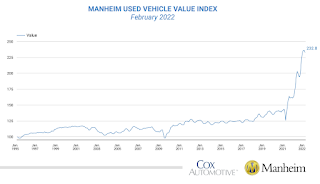 Click on graph for larger image.
Click on graph for larger image.This index from Manheim Consulting is based on all completed sales transactions at Manheim’s U.S. auctions.
Six High Frequency Indicators for the Economy
by Calculated Risk on 3/07/2022 08:57:00 AM
These indicators are mostly for travel and entertainment. It is interesting to watch these sectors recover as the pandemic subsides.
The TSA is providing daily travel numbers.
This data is as of March7th.
 Click on graph for larger image.
Click on graph for larger image.This data shows the 7-day average of daily total traveler throughput from the TSA for 2019 (Light Blue), 2020 (Black), 2021 (Blue) and 2022 (Red).
The dashed line is the percent of 2019 for the seven-day average.
The 7-day average is down 15.2% from the same day in 2019 (84.8% of 2019). (Dashed line)
The second graph shows the 7-day average of the year-over-year change in diners as tabulated by OpenTable for the US and several selected cities.
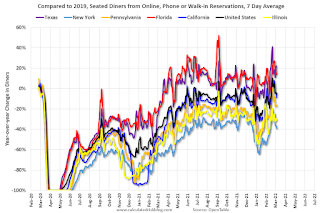 Thanks to OpenTable for providing this restaurant data:
Thanks to OpenTable for providing this restaurant data:This data is updated through March 5, 2022.
This data is "a sample of restaurants on the OpenTable network across all channels: online reservations, phone reservations, and walk-ins. For year-over-year comparisons by day, we compare to the same day of the week from the same week in the previous year."
Dining was mostly moving sideways but declined during the winter wave of COVID and is now increasing. The 7-day average for the US is down 5% compared to 2019.
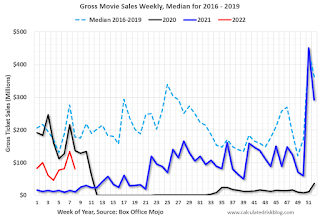 This data shows domestic box office for each week and the median for the years 2016 through 2019 (dashed light blue).
This data shows domestic box office for each week and the median for the years 2016 through 2019 (dashed light blue). Note that the data is usually noisy week-to-week and depends on when blockbusters are released.
Movie ticket sales were at $80 million last week, down about 55% from the median for the week.
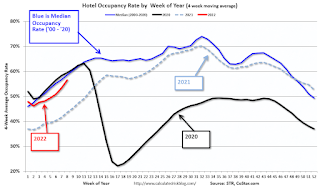 This graph shows the seasonal pattern for the hotel occupancy rate using the four-week average.
This graph shows the seasonal pattern for the hotel occupancy rate using the four-week average. The red line is for 2022, black is 2020, blue is the median, and dashed light blue is for 2021.
This data is through February 26th. The occupancy rate was down 4.7% compared to the same week in 2019.
Notes: Y-axis doesn't start at zero to better show the seasonal change.
This graph is from Apple mobility. From Apple: "This data is generated by counting the number of requests made to Apple Maps for directions in select countries/regions, sub-regions, and cities." This is just a general guide - people that regularly commute probably don't ask for directions.
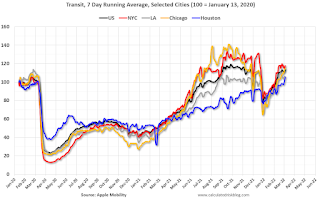 This data is through March 4th
This data is through March 4th The graph is the running 7-day average to remove the impact of weekends.
IMPORTANT: All data is relative to January 13, 2020. This data is NOT Seasonally Adjusted. People walk and drive more when the weather is nice, so I'm just using the transit data.
According to the Apple data directions requests, public transit in the 7-day average for the US is at 113% of the January 2020 level.
Here is some interesting data on New York subway usage (HT BR).
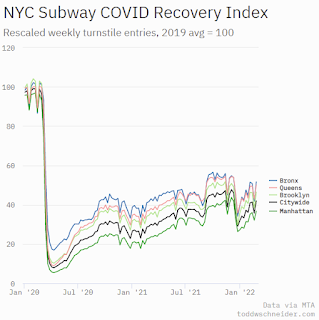 This graph is from Todd W Schneider.
This graph is from Todd W Schneider. This data is through Friday, March 4th.
He notes: "Data updates weekly from the MTA’s public turnstile data, usually on Saturday mornings".
Sunday, March 06, 2022
Sunday Night Futures
by Calculated Risk on 3/06/2022 07:12:00 PM
Weekend:
• Schedule for Week of March 6, 2022
Monday:
• No major economic releases scheduled.
From CNBC: Pre-Market Data and Bloomberg futures S&P 500 futures are down 58, and and DOW futures are down 311 fair value).
Oil prices were up over the last week with WTI futures at $126.76 per barrel and Brent at $129.86 per barrel. A year ago, WTI was at $65, and Brent was at $70 - so WTI oil prices are up almost double year-over-year.
Here is a graph from Gasbuddy.com for nationwide gasoline prices. Nationally prices are at $4.06 per gallon. A year ago prices were at $2.77 per gallon, so gasoline prices are up $1.25 per gallon year-over-year.
Weather Adjusted Employment Gains in February
by Calculated Risk on 3/06/2022 11:55:00 AM
This is something I like to check during the Winter.
The BLS reported 161 thousand people were employed in non-agriculture industries, with a job, but not at work due to bad weather. The average for February over the previous 10 years was 347 thousand. The median was 248 thousand.
The BLS also reported 592 thousand people were usually full-time employees but were working part time in February due to bad weather. The average for February over the previous 10 years was 1.54 million. The median was 708 thousand.

The San Francisco Fed estimates Weather-Adjusted Change in Total Nonfarm Employment (monthly change, seasonally adjusted). They use local area weather to estimate the impact on employment.
Saturday, March 05, 2022
Real Estate Newsletter Articles this Week
by Calculated Risk on 3/05/2022 02:11:00 PM
At the Calculated Risk Real Estate Newsletter this week:
• Delinquencies, Foreclosures and REO
• The War and Mortgage Rates
• Rents Still Increasing Sharply Year-over-year Higher Rents will impact measures of inflation in 2022
• Median vs Repeat Sales Index House Prices
This is usually published several times a week and provides more in-depth analysis of the housing market.
You can subscribe at https://calculatedrisk.substack.com/ Most content is available for free (and no Ads), but please subscribe!
Schedule for Week of March 6, 2022
by Calculated Risk on 3/05/2022 08:11:00 AM
The key report scheduled for this week is February CPI.
No major economic releases scheduled.
6:00 AM ET: NFIB Small Business Optimism Index for February.
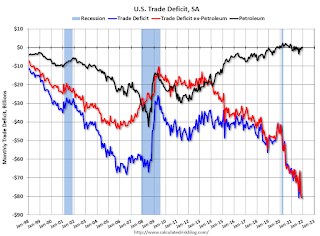 8:30 AM: Trade Balance report for January from the Census Bureau.
8:30 AM: Trade Balance report for January from the Census Bureau. This graph shows the U.S. trade deficit, with and without petroleum, through the most recent report. The blue line is the total deficit, and the black line is the petroleum deficit, and the red line is the trade deficit ex-petroleum products.
The consensus is the trade deficit to be $87.1 billion. The U.S. trade deficit was at $80.7 Billion in December.
7:00 AM ET: The Mortgage Bankers Association (MBA) will release the results for the mortgage purchase applications index.
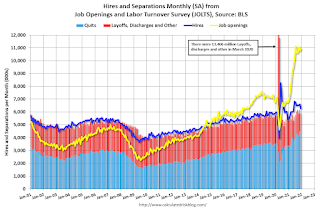 10:00 AM ET: Job Openings and Labor Turnover Survey for January from the BLS.
10:00 AM ET: Job Openings and Labor Turnover Survey for January from the BLS. This graph shows job openings (yellow line), hires (purple), Layoff, Discharges and other (red column), and Quits (light blue column) from the JOLTS.
Jobs openings increased in December to 10.9 million from 10.8 million in November.
8:30 AM: The Consumer Price Index for February from the BLS. The consensus is for a 0.8% increase in CPI, and a 0.5% increase in core CPI. The consensus is for CPI to be up 7.9% Year-over-year (YoY), and core CPI to be up 6.4% YoY.
8:30 AM: The initial weekly unemployment claims report will be released. The consensus is for a decrease to 210 thousand from 215 thousand last week.
12:00 PM: Q4 Flow of Funds Accounts of the United States from the Federal Reserve.
10:00 AM: University of Michigan's Consumer sentiment index (Preliminary for March).
Friday, March 04, 2022
COVID Update: March 4, 2022; Under 50,000 New Cases First Time Since July 2021
by Calculated Risk on 3/04/2022 09:15:00 PM
On COVID (focus on hospitalizations and deaths):
| COVID Metrics | ||||
|---|---|---|---|---|
| Now | Week Ago | Goal | ||
| Percent fully Vaccinated | 65.1% | --- | ≥70.0%1 | |
| Fully Vaccinated (millions) | 216.0 | --- | ≥2321 | |
| New Cases per Day3 | 49,888 | 70,968 | ≤5,0002 | |
| Hospitalized3 | 36,278 | 51,764 | ≤3,0002 | |
| Deaths per Day3 | 1,413 | 1,739 | ≤502 | |
| 1 Minimum to achieve "herd immunity" (estimated between 70% and 85%). 2my goals to stop daily posts, 37-day average for Cases, Currently Hospitalized, and Deaths 🚩 Increasing 7-day average week-over-week for Cases, Hospitalized, and Deaths ✅ Goal met. | ||||
 Click on graph for larger image.
Click on graph for larger image.This graph shows the daily (columns) and 7-day average (line) of deaths reported.


